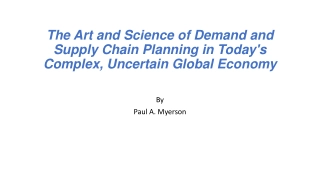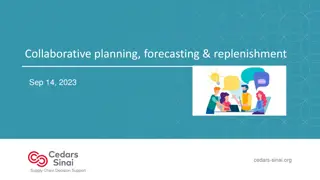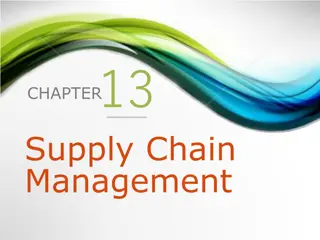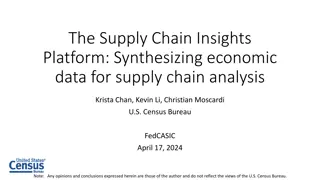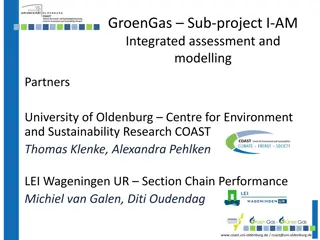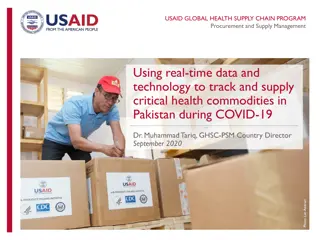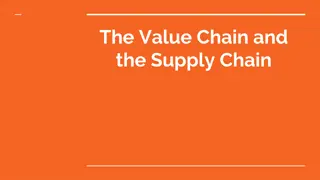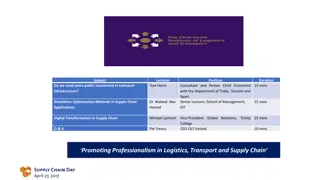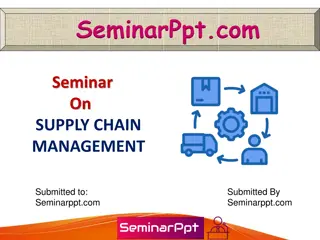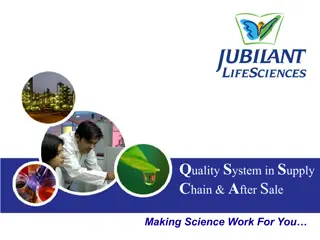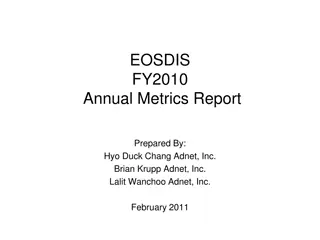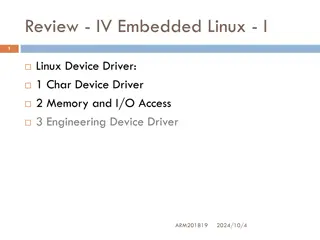
Supply Chain Performance Drivers and Metrics Overview
Explore the key impellers of the supply chain and the framework for structuring drivers. Learn about facilities, inventory, transportation, information, sourcing, and pricing as essential components affecting supply chain performance. Discover how competitive strategy and supply chain structure play critical roles in driving efficiency and responsiveness.
Download Presentation

Please find below an Image/Link to download the presentation.
The content on the website is provided AS IS for your information and personal use only. It may not be sold, licensed, or shared on other websites without obtaining consent from the author. If you encounter any issues during the download, it is possible that the publisher has removed the file from their server.
You are allowed to download the files provided on this website for personal or commercial use, subject to the condition that they are used lawfully. All files are the property of their respective owners.
The content on the website is provided AS IS for your information and personal use only. It may not be sold, licensed, or shared on other websites without obtaining consent from the author.
E N D
Presentation Transcript
Value Chain Management MGT804 Week 3 Supply Chain Drivers and Metrics
Outline Impellers of Supply Chain Supply Chain Concepts Drivers of supply chain performance A framework for structuring drivers Facilities Inventory Transportation Information Sourcing Pricing Obstacles to achieving fit 3-3
IMPELLERS OF SUPPLY CHAIN Empowered Customer Developments in Information Technology Tools Globalisation 3-4
SUPPLY CHAIN CONCEPTS Systems Concept Total Cost Concept Trade off Concept 3-5
Drivers of Supply Chain Performance Facilities places where inventory is stored, assembled, or fabricated production sites and storage sites Inventory raw materials, WIP, finished goods within a supply chain inventory policies Transportation moving inventory from point to point in a supply chain combinations of transportation modes and routes Information data and analysis regarding inventory, transportation, facilities throughout the supply chain potentially the biggest driver of supply chain performance Sourcing functions a firm performs and functions that are outsourced Pricing Price associated with goods and services provided by a firm to the supply chain 3-6
A Framework for Structuring Drivers Competitive Strategy Supply Chain Strategy Efficiency Responsiveness Supply chain structure Logistical Drivers Facilities Inventory Transportation Information Sourcing Pricing Cross Functional Drivers 3-7
Facilities Role in the supply chain the where of the supply chain manufacturing or storage (warehouses) Role in the competitive strategy economies of scale (efficiency priority) larger number of smaller facilities (responsiveness priority) Example 3.1: Toyota and Honda Components of facilities decisions 3-8
Components of Facilities Decisions Location centralization (efficiency) vs. decentralization (responsiveness) other factors to consider (e.g., proximity to customers) Capacity (flexibility versus efficiency) Manufacturing methodology (product focused versus process focused) Warehousing methodology (SKU storage, job lot storage, cross- docking) Overall trade-off: Responsiveness versus efficiency 3-9
Inventory Role in the supply chain Role in the competitive strategy Components of inventory decisions 3-10
Inventory: Role in the Supply Chain Inventory exists because of a mismatch between supply and demand Source of cost and influence on responsiveness Impact on material flow time: time elapsed between when material enters the supply chain to when it exits the supply chain throughput rate at which sales to end consumers occur I = DT (Little s Law) I = inventory; D = throughput; T = flow time Example Inventory and throughput are synonymous in a supply chain 3-11
Inventory: Role in Competitive Strategy If responsiveness is a strategic competitive priority, a firm can locate larger amounts of inventory closer to customers If cost is more important, inventory can be reduced to make the firm more efficient Trade-off Example 3.2 Nordstrom 3-12
Components of Inventory Decisions Cycle inventory Average amount of inventory used to satisfy demand between shipments Depends on lot size Safety inventory inventory held in case demand exceeds expectations costs of carrying too much inventory versus cost of losing sales Seasonal inventory inventory built up to counter predictable variability in demand cost of carrying additional inventory versus cost of flexible production Overall trade-off: Responsiveness versus efficiency more inventory: greater responsiveness but greater cost less inventory: lower cost but lower responsiveness 3-13
Transportation Role in the supply chain Role in the competitive strategy Components of transportation decisions 3-14
Transportation: Role in the Supply Chain Moves the product between stages in the supply chain Impact on responsiveness and efficiency Faster transportation allows greater responsiveness but lower efficiency Also affects inventory and facilities 3-15
Transportation: Role in the Competitive Strategy If responsiveness is a strategic competitive priority, then faster transportation modes can provide greater responsiveness to customers who are willing to pay for it Can also use slower transportation modes for customers whose priority is price (cost) Can also consider both inventory and transportation to find the right balance Example 3.3: Blue Nile 3-16
Components of Transportation Decisions Mode of transportation: air, truck, rail, ship, pipeline, electronic transportation vary in cost, speed, size of shipment, flexibility Route and network selection route: path along which a product is shipped network: collection of locations and routes In-house or outsource Overall trade-off: Responsiveness versus efficiency 3-17
Information Role in the supply chain Role in the competitive strategy Components of information decisions 3-18
Information: Role in the Supply Chain The connection between the various stages in the supply chain allows coordination between stages Crucial to daily operation of each stage in a supply chain e.g., production scheduling, inventory levels 3-19
Information: Role in the Competitive Strategy Allows supply chain to become more efficient and more responsive at the same time (reduces the need for a trade-off) Information technology What information is most valuable? Example 3.4: Andersen Windows Example 3.5: Sunsweet Growers 3-20
Components of Information Decisions Push (MRP) versus pull (demand information transmitted quickly throughout the supply chain) Coordination and information sharing Forecasting and aggregate planning Enabling technologies EDI Internet ERP systems Supply Chain Management software Overall trade-off: Responsiveness versus efficiency 3-21
Sourcing Role in the supply chain Role in the competitive strategy Components of sourcing decisions 3-22
Sourcing: Role in the Supply Chain Set of business processes required to purchase goods and services in a supply chain Supplier selection, single vs. multiple suppliers, contract negotiation 3-23
Sourcing: Role in the Competitive Strategy Sourcing decisions are crucial because they affect the level of efficiency and responsiveness in a supply chain In-house vs. outsource decisions- improving efficiency and responsiveness Example 3.6: Cisco 3-24
Components of Sourcing Decisions In-house versus outsource decisions Supplier evaluation and selection Procurement process Overall trade-off: Increase the supply chain profits 3-25
Pricing Role in the supply chain Role in the competitive strategy Components of pricing decisions 3-26
Pricing: Role in the Supply Chain Pricing determines the amount to charge customers in a supply chain Pricing strategies can be used to match demand and supply 3-27
Sourcing: Role in the Competitive Strategy Firms can utilize optimal pricing strategies to improve efficiency and responsiveness Low price and low product availability; vary prices by response times Example 3.7: Amazon.com 3-28
Components of Pricing Decisions Pricing and economies of scale Everyday low pricing versus high-low pricing Fixed price versus menu pricing Overall trade-off: Increase the firm profits 3-29
Obstacles to Achieving Strategic Fit Increasing variety of products Decreasing product life cycles Increasingly demanding customers Fragmentation of supply chain ownership Globalization Difficulty executing new strategies 3-30
Summary What are the major drivers of supply chain performance? What is the role of each driver in creating strategic fit between supply chain strategy and competitive strategy (or between implied demand uncertainty and supply chain responsiveness)? What are the major obstacles to achieving strategic fit? In the remainder of the course, we will learn how to make decisions with respect to these drivers in order to achieve strategic fit and surmount these obstacles 3-31
Further Reading: Ahmed, W., & Omar, M. (2017). Drivers of supply chain transparency and its effects on performance measures in the automotive industry: case of a developing country. International Journal of services and operations management. Chand, P., Thakkar, J. J., & Ghosh, K. K. (2018). Analysis of supply chain complexity drivers for Indian mining equipment manufacturing companies combining SAP-LAP and AHP. Resources Policy. Maestrini, V., Luzzini, D., Maccarrone, P., & Caniato, F. (2017). Supply chain performance measurement systems: A systematic review and research agenda. International Journal of Production Economics, 183, 299-315.
Cunha Callado, A. A., & Jack, L. (2015). Balanced scorecard metrics and specific supply chain roles. International Journal of Productivity and Performance Management, 64(2), 288-300. Bode, C., & Wagner, S. M. (2015). Structural drivers of upstream supply chain complexity and the frequency of supply chain disruptions. Journal of Operations Management, 36, 215-228. Wang, B., Kang, Y., Childerhouse, P., & Huo, B. (2018). Interpersonal and inter-organizational relationship drivers of supply chain integration. Industrial Management & Data Systems, 118(6), 1170-1191.

